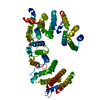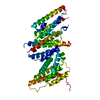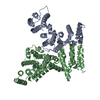Entry Database : EMDB / ID : EMD-28037Title Cryo-EM structure of the full-length human NF1 dimer body4 Complex : Full-length human NF1_body4Protein or peptide : Isoform I of Neurofibromin / / / Function / homology Function Domain/homology Component
/ / / / / / / / / / / / / / / / / / / / / / / / / / / / / / / / / / / / / / / / / / / / / / / / / / / / / / / / / / / / / / / / / / / / / / / / / / / / / / / / / / / / / / / / / / / / / / / / / / / / / / / / / / / / / / / / / / / / / / / / / / / / / / / / / / / / / Biological species Homo sapiens (human)Method / / Resolution : 3.8 Å Darling JE / Merk A / Grisshammer R / Ognjenovic J Funding support Organization Grant number Country National Institutes of Health/National Cancer Institute (NIH/NCI)
Journal : To Be Published Title : Cryo-EM structure of the full-length human NF1 dimerAuthors : Ognjenovic J / Merk A History Deposition Sep 5, 2022 - Header (metadata) release Sep 20, 2023 - Map release Sep 20, 2023 - Update May 28, 2025 - Current status May 28, 2025 Processing site : RCSB / Status : Released
Show all Show less
 Open data
Open data Basic information
Basic information
 Map data
Map data Sample
Sample Keywords
Keywords Function and homology information
Function and homology information Homo sapiens (human)
Homo sapiens (human) Authors
Authors United States, 1 items
United States, 1 items  Citation
Citation Journal: To Be Published
Journal: To Be Published Structure visualization
Structure visualization Downloads & links
Downloads & links emd_28037.map.gz
emd_28037.map.gz EMDB map data format
EMDB map data format emd-28037-v30.xml
emd-28037-v30.xml emd-28037.xml
emd-28037.xml EMDB header
EMDB header emd_28037.png
emd_28037.png emd_28037_msk_1.map
emd_28037_msk_1.map Mask map
Mask map emd-28037.cif.gz
emd-28037.cif.gz emd_28037_half_map_1.map.gz
emd_28037_half_map_1.map.gz emd_28037_half_map_2.map.gz
emd_28037_half_map_2.map.gz http://ftp.pdbj.org/pub/emdb/structures/EMD-28037
http://ftp.pdbj.org/pub/emdb/structures/EMD-28037 ftp://ftp.pdbj.org/pub/emdb/structures/EMD-28037
ftp://ftp.pdbj.org/pub/emdb/structures/EMD-28037


 F&H Search
F&H Search Links
Links EMDB (EBI/PDBe) /
EMDB (EBI/PDBe) /  EMDataResource
EMDataResource Map
Map Download / File: emd_28037.map.gz / Format: CCP4 / Size: 64 MB / Type: IMAGE STORED AS FLOATING POINT NUMBER (4 BYTES)
Download / File: emd_28037.map.gz / Format: CCP4 / Size: 64 MB / Type: IMAGE STORED AS FLOATING POINT NUMBER (4 BYTES) emd_28037_msk_1.map
emd_28037_msk_1.map Sample components
Sample components Homo sapiens (human)
Homo sapiens (human) Homo sapiens (human)
Homo sapiens (human)
 Processing
Processing Sample preparation
Sample preparation Electron microscopy
Electron microscopy Movie
Movie Controller
Controller








 Z (Sec.)
Z (Sec.) Y (Row.)
Y (Row.) X (Col.)
X (Col.)












































